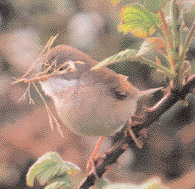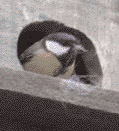|
Wildlife
Newsletter for the Township of Dalkey June 2013 - Michael Ryan |
THE
ANIMALS IN TROUBLE What to do when you find an animal or bird in distress can be quite a dilemma. If it’s evidently injured or seems to be in pain it’s obvious you should take it to a vet or get in contact with the DSPCA, if it’s lucky enough to be during their opening hours. But finding an animal that seems to be young and abandoned or in an unsafe environment can leave you wondering whether to take it away and try and help it or leave it to its fate. Its parents might be nearby watching it and you mightn’t be doing it any favour by removing it. We were returning back after a early morning bird survey in North Wexford and had just passed through Aughrim when I saw something moving across the grass verge towards the road. There was a turn off the road just after so we were able to pull in. I walked back and sure enough it was a hedgehog, now on the pavement and still heading towards the busy road. If you can get your hands under a hedgehog before they curl up into a ball you can lift them up without inflicting pain on yourself. I was able to scoop it up and it instantly wrapped itself around my hand. Initially I had thought to take it across the road and then release it but I had heard that if a hedgehog is moving about during the day there’s probably something wrong with it and this was midday in bright sunshine. Also, it was the smallest hedgehog I’d ever seen, about one third the size of ones I’d normally encounter. It seemed very early in the year (mid April) for it to possibly be a juvenile born this year, it was more likely to be a underweight adult. I decided the best thing would be to take it home and see if I could get it checked out. |
We put it in a shopping bag and it almost instantly fell asleep in the front of the car and stayed that way for the rest of the drive. When we got home we put it in a large cardboard box and I tried to find somewhere it could be checked out. The DSPCA was closed as was my regular vet. Meanwhile it seemed very happy to get some water I gave it in a small dish and some small pieces of ham and dog food I put in the box were instantly gobbled up. I found another vet who was still open for the next 30 minutes but this time I had to travel alone so I put the hedgehog inside a shoebox, with air holes made in the lid, put the box inside a big, heavy duty shopping bag, put that down on the floor behind the front seats and headed off. As I drove I could hear scuffling noises from the bag and when pulled up outside the veterinary surgery the hedgehog was sitting up on the back seat. I picked it up and it curled tightly round my hand again, like a bizarre boxing glove. It certainly didn’t seem ill since it had forced its way out of the box and climbed up on to the back seat and after a check up by the vet it was declared fit and healthy. |
| |
|
LONELY MALES AND EMPTY NESTS After initially being very slow to arrive a few mild days in late April brought in big falls of migrant birds. I saw my first Swift on the 25th April over the Vico Road, early enough for a species that usually isn’t seen before the early days of May, possibly carried in on the southerly winds that were blowing at the time. That same evening I heard, then saw my first Whitethroat of the year below the Vico Road and although one has been calling there regularly every summer for many years it’s always a relief to hear its very distinct call and know it has safely made the long journey from its wintering ground in Africa to sing above Killiney Bay. As usual it was moving around over quite a big area and at one stage seemed to have sang from the top of every single tree, gorse bush and bramble patch in the vicinity. I was following it around taking lots of photos and in one of them I saw it actually had nesting material in its bill. This seemed a bit odd, there was no sign of a female bird and if there had been one it would probably have been easy to see, helping build the nest. Curious, I did a Google search of ‘male whitethroats nest building’ and came up with some interesting observations made by a naturalist, Stanley Lewis around 1927. He had been wondering about the number of whitethroat nests he found that never contained eggs. |
 |
Whitethroat
Singing |
 |
All these nests that he had found were of fragile construction
with no hair lining and compared to nests that actually had eggs in
them had a very unfinished appearance. He had also observed a male whitethroat
decorating one of these nests while a female sat on eggs in a nest eight
yards away. Lewis had been sent a copy of the Irish Naturalist for 1918
in which a Mr. J.P. Burkitt had written about this topic and had concluded
that these nests were built by unmated ‘lonely males’ and
that a single male may build even up to four such nests but when mated
the male does no further nest building at all, leaving the female to
construct a proper nest or complete one of the ones he’d started.
Lewis himself thought the dummy nests might be to distract attention
from the real nest. In 2011 there was quite a big influx of whitethroats
with at least three males singing on the hills as well as the usual
reliable Vico male singing but that pattern hasn’t been repeated
since. Hopefully our ‘lonely male’ will get a partner. |
| Whitethroat with nest matter |
|
LITTLE FEET We’d seen a Great Tit gathering up discarded dog hair and taking it in to a squirrel nest box which would be at least three times bigger then a normal bird box the great tit might use. We’d previously seen a red squirrel on Killiney Hill that we thought looked pregnant so with a bit of luck there might be little feet, other then birds, in the boxes soon. |
 Great Tit in Squirrels Nest |